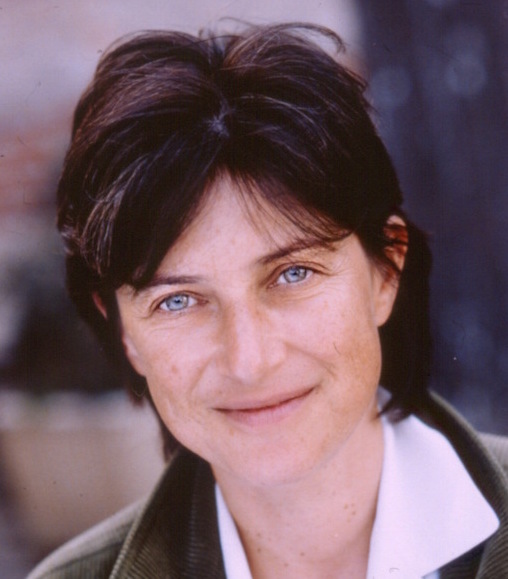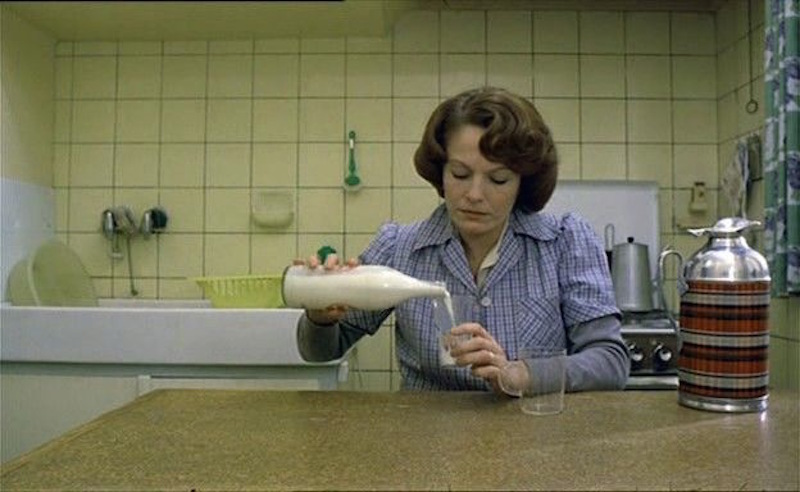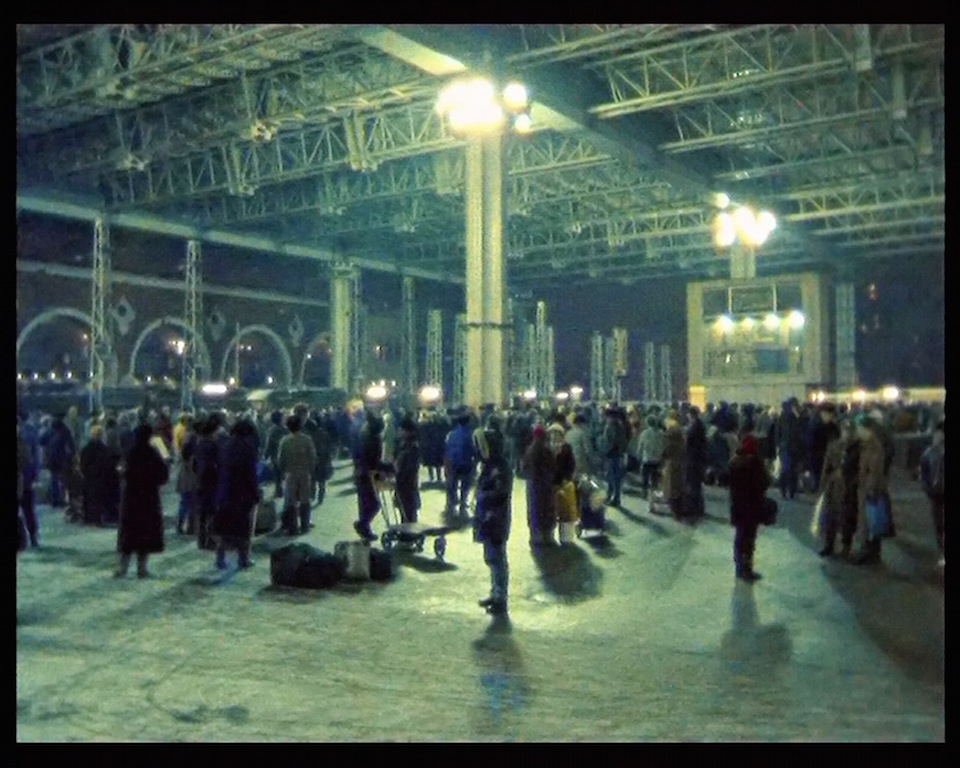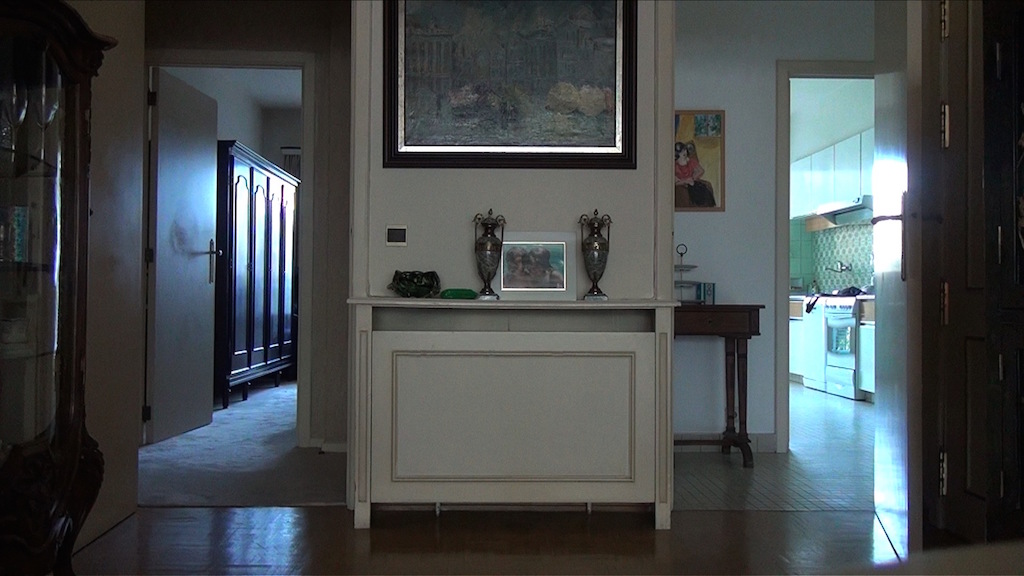Chantal Akerman: NOW, Ambika P3 | reviews, news & interviews
Chantal Akerman: NOW, Ambika P3
Chantal Akerman: NOW, Ambika P3
The most important European director of her generation - but have you heard of her?

Belgian filmmaker Chantal Akerman used her camera to record, with a sympathetic eye, the world around her – both in the immediate surroundings of her Paris flat and in the wider world. The news that she died last month, apparently by her own hand, sadly makes this retrospective of the installations she began creating in 1995 all the more timely.
Akerman (pictured below right) is best known for films such as Jeanne Dielman, 23 Quai du Commerce and 1080 Bruxelles (pictured below full column), a three-hour feature made in 1975 when she was just 24 that has since been showered with accolades. In 2012, for instance, it tied with Alfred Hitchcock’s Psycho for 35th place in Sight and Sound’s list of the greatest films.
 Rather like a Vermeer painting, it records in beautifully constructed shots the humdrum life of a single mother as she performs mundane domestic tasks such as peeling potatoes, pouring milk and fixing her make-up. The emotional emptiness of her life is brought home by the loveless sex she has each day with a man who pays for it. Rather than making her pitiable, though, Akerman celebrates the unwavering love and support she gives her son with meticulous camerawork whose measured pace keeps faith with the ordinariness of the woman’s life – until, that is, she cracks and kills!
Rather like a Vermeer painting, it records in beautifully constructed shots the humdrum life of a single mother as she performs mundane domestic tasks such as peeling potatoes, pouring milk and fixing her make-up. The emotional emptiness of her life is brought home by the loveless sex she has each day with a man who pays for it. Rather than making her pitiable, though, Akerman celebrates the unwavering love and support she gives her son with meticulous camerawork whose measured pace keeps faith with the ordinariness of the woman’s life – until, that is, she cracks and kills!
The timing is crucial. If the glacially slow unravelling of Jeanne Dielman... chills the bones, NOW (2015), a multi-screen installation that gives the exhibition its title, scorches with its manic tempo (main picture). Projected onto five screens, sepia-toned shots of desert landscapes taken from a speeding car race across one’s field of vision. An occasional road sign or pylon indicates human presence, otherwise all seems to be wilderness.
But the space is filled with sounds of conflict; explosions, rifle and machine-gun fire, shouts and screams, sirens and a horse whinnying with fear induce a growing sense of panic by painting a picture of all-enveloping chaos. This hideous cacophony must resemble the soundscape of war zones such as Syria and, sure enough, the footage is of contested territories in the Middle East.
 This compelling evocation of violence has been achieved with incredibly simple means. Everything is left to the viewer’s imagination; rather than being a passive recipient of shocking (but titillating) images of war, we are invited to project ourselves into the melée, which makes the experience far more potent.
This compelling evocation of violence has been achieved with incredibly simple means. Everything is left to the viewer’s imagination; rather than being a passive recipient of shocking (but titillating) images of war, we are invited to project ourselves into the melée, which makes the experience far more potent.
In her work, though, Akerman more often pays homage to people and things by witnessing them with sympathy and respect. Filmed in her Paris apartment, Maniac Summer (2009) consists of views through the window alongside shots of the interior. We see the artist eating breakfast and making phone calls, but watching is not always this benign. A series of projections shows shots of pedestrians in the street, children in the park and the flats opposite progressively degrading from full-bodied, full-colour images to stark, black-and-white silhouettes resembling shadows. Looking acquires sinister overtones as it seems to morph from harmless observation into predatory surveillance.
 Four years after the end of the Cold War, the inhabitants of Eastern Europe appear to be waiting, wearily, for a rebirth. First made as a feature film, 1995's From the East: Bordering on Fiction (pictured right) is shown here on 24 monitors – split into segments that reinforce the message. It's winter and people bundled up against the cold wait patiently for buses or trains, or else drive along wide boulevards probably designed for tanks. No one speaks or smiles and no one, except for a young soldier and a woman (pictured), who seems amused by the camera, shows any sign of animation.
Four years after the end of the Cold War, the inhabitants of Eastern Europe appear to be waiting, wearily, for a rebirth. First made as a feature film, 1995's From the East: Bordering on Fiction (pictured right) is shown here on 24 monitors – split into segments that reinforce the message. It's winter and people bundled up against the cold wait patiently for buses or trains, or else drive along wide boulevards probably designed for tanks. No one speaks or smiles and no one, except for a young soldier and a woman (pictured), who seems amused by the camera, shows any sign of animation.
Shanghai, on the other hand, seems to be burgeoning with life. As night falls, the glass walls of the tower blocks become giant screens displaying adverts and films of the wildlife destroyed by the rapid development exemplified by the host buildings. Soon pictures of birds and animals will be all that’s left of the things displaced by hi-tech living. The irony is that both the images and Akerman’s film are extremely seductive. Is this the apocalyptic sublime?
Maniac Shadows (2013) is divided into two parts. In the first room, three screens juxtapose shots of an interior, in which Akerman and her mother potter about (the same flat in No Home Movie, 2015, pictured below) with views of a New York street party, the broadcast of Obama’s election party, glorious shots of the sky and the filmmaker walking on the beach or huddled behind the bedclothes. The window bars and fine mesh of the screens, the slats of the blinds and the balcony railings serve to emphasise the protective (or imprisoning) boundary between inside and out – the private and the public realms.
 Meanwhile in the other space, Akerman reads My Mother Laughs, a script she wrote detailing her elderly mother’s recovery from a heart operation. This moving account of the limitations placed on people by failing health, which confines them to the domestic arena, is a tribute to the woman whose death the following year probably precipitated Akerman’s suicide.
Meanwhile in the other space, Akerman reads My Mother Laughs, a script she wrote detailing her elderly mother’s recovery from a heart operation. This moving account of the limitations placed on people by failing health, which confines them to the domestic arena, is a tribute to the woman whose death the following year probably precipitated Akerman’s suicide.
Described in the Village Voice as “the most important European director of her generation”, Akerman created over 40 films. The installations on show provide a flavour of her subtle and uniquely thoughtful approach to the dispassionate art of witnessing.
Overleaf: watch an interview with Chantal Akerman
Explore topics
Share this article
The future of Arts Journalism
You can stop theartsdesk.com closing!
We urgently need financing to survive. Our fundraising drive has thus far raised £49,000 but we need to reach £100,000 or we will be forced to close. Please contribute here: https://gofund.me/c3f6033d
And if you can forward this information to anyone who might assist, we’d be grateful.

Subscribe to theartsdesk.com
Thank you for continuing to read our work on theartsdesk.com. For unlimited access to every article in its entirety, including our archive of more than 15,000 pieces, we're asking for £5 per month or £40 per year. We feel it's a very good deal, and hope you do too.
To take a subscription now simply click here.
And if you're looking for that extra gift for a friend or family member, why not treat them to a theartsdesk.com gift subscription?
more Visual arts
 'We are bowled over!' Thank you for your messages of love and support
Much-appreciated words of commendation from readers and the cultural community
'We are bowled over!' Thank you for your messages of love and support
Much-appreciated words of commendation from readers and the cultural community
 Lee Miller, Tate Britain review - an extraordinary career that remains an enigma
Fashion photographer, artist or war reporter; will the real Lee Miller please step forward?
Lee Miller, Tate Britain review - an extraordinary career that remains an enigma
Fashion photographer, artist or war reporter; will the real Lee Miller please step forward?
 Kerry James Marshall: The Histories, Royal Academy review - a triumphant celebration of blackness
Room after room of glorious paintings
Kerry James Marshall: The Histories, Royal Academy review - a triumphant celebration of blackness
Room after room of glorious paintings
 Folkestone Triennial 2025 - landscape, seascape, art lovers' escape
Locally rooted festival brings home many but not all global concerns
Folkestone Triennial 2025 - landscape, seascape, art lovers' escape
Locally rooted festival brings home many but not all global concerns
 Sir Brian Clarke (1953-2025) - a personal tribute
Remembering an artist with a gift for the transcendent
Sir Brian Clarke (1953-2025) - a personal tribute
Remembering an artist with a gift for the transcendent
 Emily Kam Kngwarray, Tate Modern review - glimpses of another world
Pictures that are an affirmation of belonging
Emily Kam Kngwarray, Tate Modern review - glimpses of another world
Pictures that are an affirmation of belonging
 Kiefer / Van Gogh, Royal Academy review - a pairing of opposites
Small scale intensity meets large scale melodrama
Kiefer / Van Gogh, Royal Academy review - a pairing of opposites
Small scale intensity meets large scale melodrama
 Jenny Saville: The Anatomy of Painting, National Portrait Gallery review - a protégé losing her way
A brilliant painter in search of a worthwhile subject
Jenny Saville: The Anatomy of Painting, National Portrait Gallery review - a protégé losing her way
A brilliant painter in search of a worthwhile subject
 Abstract Erotic, Courtauld Gallery review - sculpture that is sensuous, funny and subversive
Testing the boundaries of good taste, and winning
Abstract Erotic, Courtauld Gallery review - sculpture that is sensuous, funny and subversive
Testing the boundaries of good taste, and winning
 Edward Burra, Tate Britain review - watercolour made mainstream
Social satire with a nasty bite
Edward Burra, Tate Britain review - watercolour made mainstream
Social satire with a nasty bite
 Ithell Colquhoun, Tate Britain review - revelations of a weird and wonderful world
Emanations from the unconscious
Ithell Colquhoun, Tate Britain review - revelations of a weird and wonderful world
Emanations from the unconscious
 Rachel Jones: Gated Canyons, Dulwich Picture Gallery review - teeth with a real bite
Mouths have never looked so good
Rachel Jones: Gated Canyons, Dulwich Picture Gallery review - teeth with a real bite
Mouths have never looked so good

Add comment